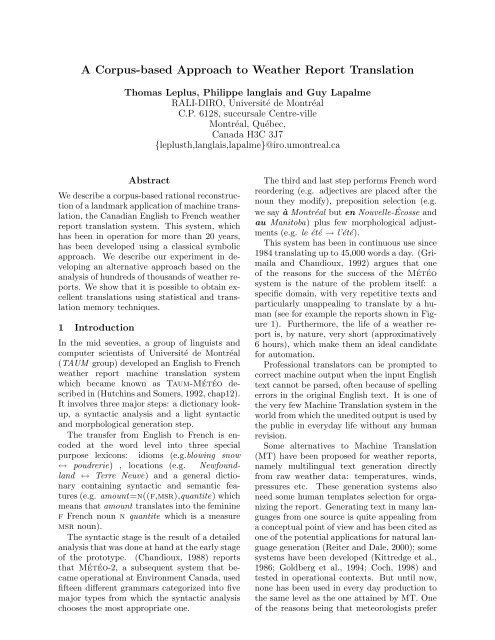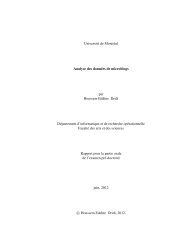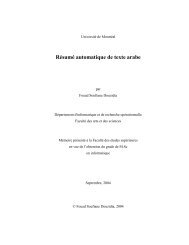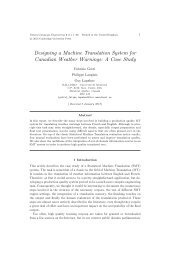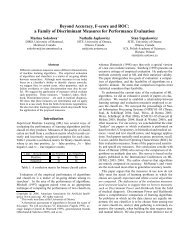A Corpus-based Approach to Weather Report Translation - RALI ...
A Corpus-based Approach to Weather Report Translation - RALI ...
A Corpus-based Approach to Weather Report Translation - RALI ...
- No tags were found...
Create successful ePaper yourself
Turn your PDF publications into a flip-book with our unique Google optimized e-Paper software.
A <strong>Corpus</strong>-<strong>based</strong> <strong>Approach</strong> <strong>to</strong> <strong>Weather</strong> <strong>Report</strong> <strong>Translation</strong><br />
Thomas Leplus, Philippe langlais and Guy Lapalme<br />
<strong>RALI</strong>-DIRO, Université de Montréal<br />
C.P. 6128, succursale Centre-ville<br />
Montréal, Québec,<br />
Canada H3C 3J7<br />
{leplusth,langlais,lapalme}@iro.umontreal.ca<br />
Abstract<br />
We describe a corpus-<strong>based</strong> rational reconstruction<br />
of a landmark application of machine translation,<br />
the Canadian English <strong>to</strong> French weather<br />
report translation system. This system, which<br />
has been in operation for more than 20 years,<br />
has been developed using a classical symbolic<br />
approach. We describe our experiment in developing<br />
an alternative approach <strong>based</strong> on the<br />
analysis of hundreds of thousands of weather reports.<br />
We show that it is possible <strong>to</strong> obtain excellent<br />
translations using statistical and translation<br />
memory techniques.<br />
1 Introduction<br />
In the mid seventies, a group of linguists and<br />
computer scientists of Université de Montréal<br />
(TAUM group) developed an English <strong>to</strong> French<br />
weather report machine translation system<br />
which became known as Taum-Météo described<br />
in (Hutchins and Somers, 1992, chap12).<br />
It involves three major steps: a dictionary lookup,<br />
a syntactic analysis and a light syntactic<br />
and morphological generation step.<br />
The transfer from English <strong>to</strong> French is encoded<br />
at the word level in<strong>to</strong> three special<br />
purpose lexicons: idioms (e.g.blowing snow<br />
↔ poudrerie) , locations (e.g. Newfoundland<br />
↔ Terre Neuve) and a general dictionary<br />
containing syntactic and semantic features<br />
(e.g. amount=n((f,msr),quantite) which<br />
means that amount translates in<strong>to</strong> the feminine<br />
f French noun n quantite which is a measure<br />
msr noun).<br />
The syntactic stage is the result of a detailed<br />
analysis that was done at hand at the early stage<br />
of the pro<strong>to</strong>type. (Chandioux, 1988) reports<br />
that Météo-2, a subsequent system that became<br />
operational at Environment Canada, used<br />
fifteen different grammars categorized in<strong>to</strong> five<br />
major types from which the syntactic analysis<br />
chooses the most appropriate one.<br />
The third and last step performs French word<br />
reordering (e.g. adjectives are placed after the<br />
noun they modify), preposition selection (e.g.<br />
we say à Montréal but en Nouvelle-Écosse and<br />
au Mani<strong>to</strong>ba) plus few morphological adjustments<br />
(e.g. le été → l’été).<br />
This system has been in continuous use since<br />
1984 translating up <strong>to</strong> 45,000 words a day. (Grimaila<br />
and Chandioux, 1992) argues that one<br />
of the reasons for the success of the Météo<br />
system is the nature of the problem itself: a<br />
specific domain, with very repetitive texts and<br />
particularly unappealing <strong>to</strong> translate by a human<br />
(see for example the reports shown in Figure<br />
1). Furthermore, the life of a weather report<br />
is, by nature, very short (approximatively<br />
6 hours), which make them an ideal candidate<br />
for au<strong>to</strong>mation.<br />
Professional transla<strong>to</strong>rs can be prompted <strong>to</strong><br />
correct machine output when the input English<br />
text cannot be parsed, often because of spelling<br />
errors in the original English text. It is one of<br />
the very few Machine <strong>Translation</strong> system in the<br />
world from which the unedited output is used by<br />
the public in everyday life without any human<br />
revision.<br />
Some alternatives <strong>to</strong> Machine <strong>Translation</strong><br />
(MT) have been proposed for weather reports,<br />
namely multilingual text generation directly<br />
from raw weather data: temperatures, winds,<br />
pressures etc. These generation systems also<br />
need some human templates selection for organizing<br />
the report. Generating text in many languages<br />
from one source is quite appealing from<br />
a conceptual point of view and has been cited as<br />
one of the potential applications for natural language<br />
generation (Reiter and Dale, 2000); some<br />
systems have been developed (Kittredge et al.,<br />
1986; Goldberg et al., 1994; Coch, 1998) and<br />
tested in operational contexts. But until now,<br />
none has been used in every day production <strong>to</strong><br />
the same level as the one attained by MT. One<br />
of the reasons being that meteorologists prefer
<strong>to</strong> write their reports in natural language rather<br />
than selecting text structure templates.<br />
Given that recent statistical and corpus approaches<br />
for machine translation have proven<br />
their value in some contexts, we decided <strong>to</strong> see<br />
how well these approaches would fit in the context<br />
of the weather report translation. We obtained<br />
from Environment Canada 309 531 forecast<br />
reports in both French and English produced<br />
during 2002 and 2003. The current reports<br />
are available on the web at http://meteo.<br />
ec.gc.ca/forecast/textforecast_f.html. This<br />
site is continually being updated. We used this<br />
corpus as a source for developing a new system<br />
for weather reports and thus gave rebirth <strong>to</strong> one<br />
of the most successful machine translation system<br />
until now.<br />
We describe in section 2 the data we received<br />
and what preprocessing we performed <strong>to</strong> obtain<br />
our Météo bitext. We present in section 3 the<br />
first pro<strong>to</strong>type we devised and report on its evaluation<br />
in section 4. We finally discuss this work<br />
in section 5.<br />
2 The corpus<br />
As our system is <strong>based</strong> on both memory and statistical<br />
<strong>based</strong> approaches, the first thing we need<br />
is a bitext i.e. an aligned corpus of corresponding<br />
sentences in French and English weather reports.<br />
Like all work on real data, this conceptually<br />
simple task proved <strong>to</strong> be more complicated<br />
that we had initially envisioned. This section<br />
describes the major steps of this stage.<br />
2.1 The raw corpus<br />
We received from Environment Canada files<br />
containing both French and English weather<br />
forecasts produced during 2002 and 2003. Both<br />
the source report, usually in English, and its<br />
translation, produced either by a human or by<br />
the current Météo system, appear in the same<br />
file. One file contains all reports issued for a<br />
single day. A report is a fairly short text, on<br />
average 304 words, in a telegraphic style: all<br />
letters are capitalized and non accented and almost<br />
always without any punctuation except<br />
for a terminating period. As can be seen in<br />
the example in Figure 1, there are few determiners<br />
such as articles (a or the in English, le<br />
or un in French). A report usually starts with<br />
a code identifying the source which issued the<br />
report. For example, in FPCN18 CWUL 312130,<br />
312130 indicates that the report was produced<br />
at 21h30 on the 31st day of the month; CWUL is<br />
a code corresponding <strong>to</strong> Montreal and the western<br />
area of Quebec. A report (almost always)<br />
ends with a closing markup: END or FIN according<br />
on the language of the report; if the author<br />
or the transla<strong>to</strong>r is a human, his or her initials<br />
are added after a slash following the markup.<br />
2.2 Matching English and French<br />
reports<br />
We first determine the beginning and end of<br />
each weather forecast using regular expressions<br />
<strong>to</strong> match the first line of a forecast, which identifies<br />
the source which issued it, and the last line<br />
which usually starts with END or FIN.<br />
Then we distinguish the English forecasts<br />
from the French ones according <strong>to</strong> whether they<br />
ended with END or FIN. Given the fact that<br />
we started with a fairly large amount of data,<br />
we decided <strong>to</strong> discard any forecast that we could<br />
not identify with this process. We were left with<br />
270 402 reports.<br />
We also had <strong>to</strong> match English and French<br />
forecasts that are translations of each other. As<br />
we see in fig. 1, the first line of the two reports is<br />
almost the same except for the first part of the<br />
source identifier which is FPCN18 in English and<br />
FPCN78 in French. After studying the data, we<br />
determined that this shift of 60 between English<br />
and French forecasts identifiers seemed valid for<br />
identifiers from FPCN10 through FPCN29. These<br />
identifiers being the most frequent, we decided<br />
<strong>to</strong> keep only these in<strong>to</strong> our final bitext.<br />
This preprocessing stage required about 1 500<br />
lines of Perl code and few weeks of moni<strong>to</strong>ring.<br />
Out of the 561 megabytes of text we received,<br />
we were left with only 410 megabytes of text,<br />
representing 127 950 weather reports pairs.<br />
2.3 Creating a bitext<br />
To get a bitext out of this selected material, we<br />
first segmented au<strong>to</strong>matically the reports in<strong>to</strong><br />
words and sentences using an in house <strong>to</strong>ol that<br />
we did not try <strong>to</strong> adapt <strong>to</strong> the specificity of the<br />
weather forecasts. Actually, this segmenter did<br />
not always managed <strong>to</strong> identify end of sentences<br />
accurately.<br />
We then ran the Japa sentence<br />
aligner (Langlais et al., 1998) that <strong>to</strong>ok<br />
around 2 hours of a desk workstation <strong>to</strong> identify<br />
4,1 million pairs of sentences from which<br />
we removed about 44 000 (roughly 1%) which<br />
were not one <strong>to</strong> one sentence pairs.<br />
We divided this bitext in<strong>to</strong> three non overlapping<br />
sections as reported in Table 1: train<br />
(January 2002 <strong>to</strong> Oc<strong>to</strong>ber 2003) for training
FPCN18 CWUL 312130<br />
SUMMARY FORECAST FOR WESTERN QUEBEC<br />
ISSUED BY ENVIRONMENT CANADA<br />
MONTREAL AT 4.30 PM EST MONDAY 31<br />
DECEMBER 2001 FOR TUESDAY 01 JANUARY<br />
2002. VARIABLE CLOUDINESS WITH<br />
FLURRIES. HIGH NEAR MINUS 7.<br />
FPCN78 CWUL 312130<br />
RESUME DES PREVISIONS POUR L’OUEST DU<br />
QUEBEC EMISES PAR ENVIRONNEMENT CANADA<br />
MONTREAL 16H30 HNE LE LUNDI 31 DECEMBRE<br />
2001 POUR MARDI LE 01 JANVIER 2002.<br />
CIEL VARIABLE AVEC AVERSES DE NEIGE.<br />
MAX PRES DE MOINS 7.<br />
END/LT<br />
FIN/TR<br />
Figure 1: An example of an English weather report and its French translation.<br />
the translation and language models, blanc<br />
(December 2003) for tuning them and test<br />
(November 2003) for testing.<br />
The test section was chosen <strong>to</strong> be different<br />
from the train period in order <strong>to</strong> recreate<br />
as much as possible the working environment<br />
of a system faced with the translation of new<br />
weather forecasts.<br />
English French<br />
corpus pairs words <strong>to</strong>ks words <strong>to</strong>ks<br />
train 3 933 30 173 9.2 36 895 10.9<br />
blanc 115 884 2.8 1 082 3.3<br />
test 34 268 1.8 330 2.0<br />
<strong>to</strong>tal 4 081 31 325 9.4 38 307 11.2<br />
Table 1: Main characteristics of the subcorpora<br />
used in this study in terms of number of pairs<br />
of sentences, English and French words and <strong>to</strong>kens.<br />
Figures are reported in thousands.<br />
2.4 Characteristics of the bitext<br />
A quick inspection of the bitext reveals that sentences<br />
are fairly short: an average of 7.6 English<br />
and 8.4 French words. Figure 2 shows the length<br />
distribution for the three sections of our bitext.<br />
Most sentences are repeated, only 8% of the<br />
English sentences being hapax. About 90% of<br />
the sentences <strong>to</strong> be translated can be retrieved<br />
with at most one edit operation i.e. insertion,<br />
suppression and substitution of a word. These<br />
properties of our bitext naturally call for a memory<br />
<strong>based</strong> approach for translating weather reports.<br />
3 The translation system<br />
The strategy we devised <strong>to</strong> build this translation<br />
system is a combination of both memory and<br />
a statistical <strong>based</strong> approaches. The scenario<br />
for translating a sentence is the following: the<br />
source sentence is preprocessed in order <strong>to</strong> handle<br />
more easily entities such as dates, hours or<br />
18<br />
16<br />
14<br />
12<br />
10<br />
8<br />
6<br />
4<br />
2<br />
%<br />
test<br />
train<br />
blanc<br />
0<br />
0 5 10 15 20 25 30<br />
source sentence length (in words)<br />
Figure 2: Distribution length of the identified<br />
English sentences.<br />
numbers (see section 3.1). Sentences which are<br />
closest <strong>to</strong> this processed source sentence are retrieved<br />
from the translation memory. If the sentences<br />
found involves few or no edit operations<br />
(a notion we quantify in section 3.2), we return<br />
the most frequent translation found; in cases<br />
where many edit operations are required, the<br />
sentence is feed <strong>to</strong> a statistical machine translation<br />
(SMT) engine. The resulting translation is<br />
then postprocessed <strong>to</strong> remove the meta-<strong>to</strong>kens<br />
introduced by the preprocessing stage. Figure<br />
3 illustrates this process for the translation of<br />
one sentence.<br />
3.1 Preprocessing<br />
Eight classes of <strong>to</strong>kens (punctuation, telephone<br />
numbers, months, days, time, numeric values,<br />
range of values and cardinal coordinates) are<br />
identified with regular expressions at the character<br />
level and replaced by a corresponding tag<br />
(numbered if there are more than one of the<br />
same class in a sentence) in the bitext. Since<br />
this preprocessing was performed before training<br />
the translation and the language models, we<br />
thus get transfer parameters such as p(time-1<br />
| time-2) as well as ngram ones such as p(int |
MONDAY .. CLOUDY PERIODS IN THE MORNING WITH 30 PERCENT CHANCE OF FLURRIES EARLY<br />
IN THE MORNING .<br />
preprocessing<br />
DAY1 PONCT1 CLOUDY PERIODS IN THE MORNING WITH INT1 PERCENT CHANCE OF<br />
FLURRIES EARLY IN THE MORNING PONCT2<br />
memory<br />
nearest source match (edit distance=3):<br />
DAY1 PONCT1 BECOMING CLOUDY EARLY<br />
IN THE MORNING WITH INT1 PERCENT<br />
CHANCE OF FLURRIES IN THE MORNING<br />
PONCT2<br />
↕<br />
DAY1 PONCT1 DEVENANT NUAGEUX TOT<br />
EN MATINEE AVEC POSSIBILITE DE INT1<br />
POUR CENT D AVERSES DE NEIGE EN MATINEE<br />
PONCT2<br />
⇓<br />
⇓ translation ⇓<br />
selection<br />
SMT<br />
DAY1 PONCT1 NUAGEUX AVEC PERCEES<br />
DE SOLEIL EN MATINEE AVEC INT1 POUR<br />
CENT DE NEIGE TOT EN MATINEE PONCT2<br />
DAY1 PONCT1 NUAGEUX AVEC NEIGE<br />
PASSAGERE EN MATINEE AVEC POSSIBILITE DE<br />
INT1 POUR CENT DE NEIGE TOT LE MATIN<br />
DAY1 PONCT1 DEVENANT NUAGEUX TOT EN MATINEE AVEC POSSIBILITE DE INT1 POUR<br />
CENT D AVERSES DE NEIGE EN MATINEE PONCT2<br />
postprocessing<br />
LUNDI .. DEVENANT NUAGEUX TOT EN MATINEE AVEC POSSIBILITE DE 30 POUR CENT D<br />
AVERSES DE NEIGE EN MATINEE .<br />
Reference translation :<br />
LUNDI .. PASSAGES NUAGEUX EN MATINEE AVEC 30 POUR CENT DE PROBABILITE D AVERSES<br />
DE NEIGE TOT EN MATINEE .<br />
Figure 3: Illustration of a translation session. The source sentence is first preprocessed. Both the<br />
memory and the SMT engine are queried. Here, the memory found only an approximative match<br />
with an edit distance of 3. The two first translations produced by the SMT engine are reported on<br />
the right column. A translation is then selected and postprocessed.<br />
possibilite de). This process is different from<br />
the creation of specialized lexicons used in the<br />
current Météo system. In particular, we did<br />
not try <strong>to</strong> join words that might be handled<br />
badly by our models (such as greater Vancouver<br />
↔ Vancouver et banlieue) nor did we explicitly<br />
encode place names. We only used au<strong>to</strong>matic<br />
<strong>to</strong>ols for building the system.<br />
3.2 The translation memory<br />
When we started <strong>to</strong> build a translation memory<br />
for our pro<strong>to</strong>type, we identified several parameters<br />
that could significantly affect the performance<br />
of the system. The main ones are its size<br />
and the number of French translations kept for<br />
each English sentence.<br />
The size of the translation memory affects<br />
our system in two ways. If we s<strong>to</strong>re only the<br />
few most frequent English sentences and their<br />
French translations, the time for the system <strong>to</strong><br />
look for entries in the memory will be short.<br />
But, on the other hand, it is clear that the bigger<br />
the memory, the better will our chances be<br />
<strong>to</strong> find sentences we want <strong>to</strong> translate (or ones<br />
within a short edit distance) even if these sentences<br />
were not frequent in the training corpus.<br />
We can see on fig. 4 that the percentage of sentences<br />
<strong>to</strong> translate found directly in the memory<br />
grows logarithmically with the size of the memory<br />
until it reaches approximately 20 000. With<br />
a memory of 320 000 sentences, we can obtain a<br />
peek of 85% of sentences found in<strong>to</strong> the memory.<br />
The second parameter for the translation
percentage of sentences found verbatim<br />
100<br />
80<br />
60<br />
40<br />
20<br />
blanc<br />
test<br />
0<br />
1 10 100 1000 10000 100000 1e+06<br />
number of sentences in the memory<br />
Figure 4: Percentage of the test and blanc<br />
sentences found verbatim as a function of the<br />
number of sentences kept in the memory.<br />
memory is the number of French translations<br />
s<strong>to</strong>red for each English sentence. Among the<br />
318 536 different English sentences found in our<br />
training corpus, as much as 289 508 (91%) always<br />
have the same translation. This is probably<br />
because most of the data we received from<br />
Environment Canada is actually machine translated<br />
and has not been edited by human transla<strong>to</strong>rs.<br />
So we decided <strong>to</strong> s<strong>to</strong>re in memory only<br />
one translation per sentence, for the 9% of sentences<br />
with several ones, we kept only the most<br />
frequent one.<br />
3.3 The translation engine<br />
We used an in house implementation of the decoder<br />
described in (Nießen et al., 1998). This<br />
decoder relies on an IBM translation model 2<br />
(Brown et al., 1993) as well as on an interpolated<br />
ngram language model. We used the<br />
train section of our bitext <strong>to</strong> train both models<br />
and used the blanc section <strong>to</strong> adjust au<strong>to</strong>matically<br />
the weighting coefficients of the language<br />
model.<br />
We must share with the reader the singular<br />
and privileged moment we had moni<strong>to</strong>ring the<br />
training. A few minutes on an ordinary desk<br />
computer where enough <strong>to</strong> make us feel what<br />
the life of computer linguist will be in (near)<br />
future: the training translation perplexity was<br />
as low as 4.7 and the language model ones were<br />
of 4.6 for the 3-gram model and 3.2 for the 5-<br />
gram one; the same 3-gram model trained on<br />
the Canadian Hansards gets a perplexity of 46,<br />
which is already very low.<br />
3.4 Postprocessing<br />
The output of the translation engine was postprocessed<br />
in order <strong>to</strong> transform the meta<strong>to</strong>kens<br />
during preprocessing in<strong>to</strong> their appropriate<br />
word form. We observed on a held-out<br />
test corpus that this cascade of pre and postprocessing<br />
(illustrated in Figure 3) slightly improved<br />
the SMT engine and clearly boosted the<br />
coverage of the memory.<br />
4 Results<br />
We report in Table 2 the performance of the<br />
SMT engine measured on the test corpus in<br />
terms of Word Error Rate (wer) and Sentence<br />
Error Rate (ser). These measurements are provided<br />
for two scenarios: one in which the system<br />
produces a single translation (1-best) and<br />
one in which the system produces at most 5<br />
translations. In the latter case, the score for<br />
a source sentence is computed using an oracle<br />
which picks the best translation among the ones<br />
proposed 1 .<br />
sent. nb 1-best 5-best<br />
length sent. wer ser wer ser<br />
0- 5 11102 20.1 47.1 4.8 15.3<br />
0-10 21970 27.6 61.5 12.1 34.6<br />
0-15 28286 26.5 68.5 14.0 43.6<br />
0-20 30911 26.7 70.7 15.7 47.7<br />
0-25 32174 26.8 71.7 16.7 49.5<br />
0-30 32958 27.0 72.3 17.4 50.7<br />
5-gram 33500 27.9 72.8 18.8 51.5<br />
3-gram 33500 27.3 73.6 19.4 53.5<br />
Table 2: Performance of the statistical engine<br />
on the test corpus (33 500 sentences) as a function<br />
of the sentence length (len). The second<br />
column indicates the number of sentences on<br />
which the evaluation is performed.<br />
Several observations can be made from Table<br />
2.Given the nature of the task, the error<br />
rates are relatively low compared <strong>to</strong> other translation<br />
tasks. On Hansard translation sessions,<br />
we usually observe with the same engine a wer<br />
around 60%, and a ser in the range of 80-90%.<br />
Second, the benefit of using a 5-gram language<br />
model over a 3-gram one is not as noticeable as<br />
we had hope: the wer of the first translation<br />
produced is even higher on average in the latter<br />
case. We found that many translations resulting<br />
of the 5-gram model were well formed, but<br />
lacked fidelity with the original source sentence.<br />
For example, in fig. 3, the translations produced<br />
1 Minimization of wer was used <strong>to</strong> simulate the oracle<br />
in this experiment.
40<br />
35<br />
30<br />
%<br />
wer 1−10<br />
wer 1−35<br />
ser 1−10<br />
ser 1−35<br />
24<br />
23.5<br />
23<br />
22.5<br />
WER (%)<br />
25<br />
22<br />
20<br />
21.5<br />
15<br />
21<br />
10<br />
5<br />
0 50000 100000 150000 200000 250000 300000<br />
number of pairs kept<br />
Figure 5: Performance of the memory-<strong>based</strong> approach<br />
as a function of the number of pair of<br />
sentences kept in the memory. Each point corresponds<br />
<strong>to</strong> a frequency threshold (from 10 <strong>to</strong><br />
1) we considered for filtering in the training sentences.<br />
A threshold of 1 (the last dot) means<br />
that all the train bitext was considered as a<br />
memory.<br />
by the SMT engine, cloudy periods in the morning<br />
is first translated as nuaugeux avec percee<br />
de soleil en matinee (cloudy with sunny periods<br />
in the morning) and the next time as nuageux<br />
avec neige passagere en matinee (cloudy with<br />
occasional snow in the morning). A possible explanation<br />
lies in our bitext which contains several<br />
very frequent sentences that are dominating<br />
the mass probability given <strong>to</strong> the ngrams<br />
(a huge unbalanced corpus is not necessarily a<br />
good one). We still observe the usual increases<br />
in the error rates with the length of the sentences<br />
<strong>to</strong> be translated.<br />
We can observe in fig. 5 the performance of<br />
the memory-<strong>based</strong> approach as a function of the<br />
number of pairs kept in the memory. Clearly<br />
the larger the memory is, the better the performance.<br />
The error rates reported are much<br />
lower than the SMT ones, even when the memory<br />
contains only the 5 000 most frequent pairs<br />
of the train corpus.<br />
Figure 6 shows the translation performance<br />
we obtain by mixing the largest memory and the<br />
SMT. Since 85% of the sentences <strong>to</strong> be translated<br />
can be found verbatim in this memory, we<br />
considered only the 15% remaining ones. We<br />
observe the best performance when the SMT is<br />
only queried for sentences with an edit distance<br />
higher than 5. In this configuration our pro<strong>to</strong>type’s<br />
wer is 20%. Finally when we keep the<br />
previous configuration but translate all the sentences<br />
of our test corpus, our pro<strong>to</strong>type perfor-<br />
20.5<br />
20<br />
edit distance<br />
19.5<br />
0 5 10 15 20<br />
Figure 6: Performance of the pro<strong>to</strong>type as a<br />
function of the threshold over which the SMT<br />
engine is queried. Only those sentences that are<br />
not verbatim in the train bitext are considered.<br />
mance is of 10% wer and 31% ser. This is only<br />
a minor argument in favor of the integration of<br />
our SMT engine, especially considering its heaviness.<br />
The Météo-1 system was credited of a<br />
sentence error rate of 20%, and the Météo-2<br />
system an accuracy of 96% (Chandioux, 1988).<br />
5 Discussion<br />
In this paper, we described the recreation of the<br />
Météo system nearly 30 years after the birth<br />
of the first pro<strong>to</strong>type at the same university.<br />
The main difference between these two systems<br />
is the way they were developed. The original<br />
system is a carefully handcrafted one <strong>based</strong> on<br />
a detailed linguistic analysis, whilst ours simply<br />
exploits a memory of previous translations<br />
of weather forecasts that were, of course, not<br />
available at the time the original system was<br />
designed. Computational resources needed for<br />
implementing this corpus <strong>based</strong> approach are<br />
also much bigger than what was even imaginable<br />
when the first Météo system was developed.<br />
We show that a particularly simple system<br />
mixing a memory <strong>based</strong> approach and a<br />
statistical one can, without almost any human<br />
effort, reproduce a quality comparable <strong>to</strong> the<br />
one produced by the current system.<br />
This pro<strong>to</strong>type can be improved on many aspects.<br />
First, we could consider a more elaborate<br />
translation model than the one we used<br />
here. We have already experienced, in another<br />
setting (Foster et al., 2003), that the theoretical<br />
benefit of an IBM model 4 does not always<br />
leads <strong>to</strong> much better word error rates on a Chinese<br />
<strong>to</strong> English translation task. It would nevertheless<br />
be interesting <strong>to</strong> measure the improvement<br />
on this specific task for which the language
and translation models can be trained on much<br />
larger data. Another interesting candidate for<br />
which we are currently devising a decoder is a<br />
phrase <strong>based</strong> model (Koehn et al., 2003). We<br />
would like <strong>to</strong> see whether the training of such<br />
a model would replace partially or completely<br />
the memory we built in this experiment, especially<br />
since the average sentence length in our<br />
bitext is about 7 words. Our translation memory<br />
implementation is by far crude compared <strong>to</strong><br />
the current practice in example-<strong>based</strong> machine<br />
translation (Carl and Way, 2003), since it only<br />
returns verbatim the most frequent translation<br />
found. While this make sense when the source<br />
sentence is found verbatim in the memory, it<br />
sounds a little bit odd <strong>to</strong> do so in the other<br />
cases. We are currently investigating the use of<br />
word alignment <strong>to</strong> better exploit our memory.<br />
Our bitext thus puts us in<strong>to</strong> a very particular<br />
and pleasing situation where we have enough<br />
highly specific data which is reflected by an efficient<br />
usage of a memory of previous translations.<br />
We have shown that a word-<strong>based</strong> statistical<br />
model can capture part of the information<br />
available in the memory. On a more polemic<br />
stance, the availability of such a huge quantity<br />
of previous translations gives us an opportunity<br />
<strong>to</strong> explore whether current SMT is much more<br />
than memorizing previous translations.<br />
6 Acknowledgements<br />
We thank Rick Jones and Marc Besner from the<br />
Dorval office of Environment Canada who provided<br />
us with the corpus of bilingual weather<br />
reports. We are also indebted <strong>to</strong> Elliot<br />
Macklovitch who provided us with articles describing<br />
the Météo system that we could not<br />
have found otherwise and <strong>to</strong> George Foster for<br />
his kind assistance in using some of his programs.<br />
This work has been granted by NSERC<br />
and FQRNT.<br />
References<br />
Peter F. Brown, Stephen A. Della Pietra, Vincent<br />
J. Della Pietra, and Robert L. Mercer.<br />
1993. The mathematics of statistical machine<br />
translation: Parameter estimation. Computational<br />
Linguistics, 19(2):263–311.<br />
Michael Carl and Andy Way, edi<strong>to</strong>rs. 2003.<br />
Recent Advances in Example-Based Machine<br />
<strong>Translation</strong>, volume 21 of Text, Speech and<br />
Language Technology. Kluwer Academic.<br />
John Chandioux. 1988. Meteo (tm), an operational<br />
translation system. In RIAO.<br />
J. Coch. 1998. Interactive generation and<br />
knowledge administration in multimeteo.<br />
In Ninth International Workshop on Natural<br />
Language Generation, pages 300–303,<br />
Niagara-on-the-lake, Ontario, Canada.<br />
G. Foster, S. Gandrabur, P. Langlais,<br />
E. Macklovitch, P. Plamondon, G. Russell,<br />
and M. Simard. 2003. Statistical machine<br />
translation: Rapid development with limited<br />
resources. In Machine <strong>Translation</strong> Summit<br />
IX, New Orleans, USA, sep.<br />
E. Goldberg, N. Driedger, and R. Kittredge.<br />
1994. Using natural language processing <strong>to</strong><br />
produce weather forecasts. IEEE Expert 9,<br />
2:45–53, apr.<br />
Annette Grimaila and John Chandioux, 1992.<br />
Made <strong>to</strong> measure solutions, chapter 3, pages<br />
33–45. J. New<strong>to</strong>n, ed., Computers in <strong>Translation</strong>:<br />
A Practical Appraisal, Routledge, London.<br />
W. John Hutchins and Harold L. Somers,<br />
1992. An introduction <strong>to</strong> Machine <strong>Translation</strong>,<br />
chapter 12, pages 207–220. Academic<br />
Press.<br />
R. Kittredge, A. Polguère, and E. Goldberg.<br />
1986. Synthesizing weather reports from formatted<br />
data. In 11th. International Conference<br />
on Computational Linguistics, pages<br />
563–565, Bonn, Germany.<br />
Philipp Koehn, Franz Josef Och, and Daniel<br />
Marcu. 2003. Statistical phrase-<strong>based</strong> translation.<br />
In Proceedings of the Second Conference<br />
on Human Language Technology<br />
Reasearch (HLT), pages 127–133, Edmon<strong>to</strong>n,<br />
Alberta, Canada, May.<br />
Philippe Langlais, Michel Simard, and Jean<br />
Véronis. 1998. Methods and practical issues<br />
in evaluating alignment techniques. In<br />
Proceedings of the 36th Annual Meeting of<br />
the Association for Computational Linguistics<br />
(ACL), Montréal, Canada, August.<br />
S. Nießen, S. Vogel, H. Ney, and C. Tillmann.<br />
1998. A dp <strong>based</strong> search algorithm for statistical<br />
machine translation. In Proceedings of<br />
the 36th Annual Meeting of the Association<br />
for Computational Linguistics (ACL) and<br />
17th International Conference on Computational<br />
Linguistics (COLING) 1998, pages<br />
960–966, Montréal, Canada, August.<br />
Ehud Reiter and Robert Dale. 2000. Building<br />
Natural Language Generation Systems. Cambridge<br />
University Press. 270 p.


